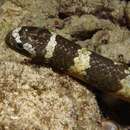en
names in breadcrumbs


Marine waters of the Ryukyu Archipelago, South China Sea, New Guinea, and northern Australia.
Type-species: Emydocephalus annulatus Krefft, 1869, by subsequent designation of Smith, 1926, and Cogger, 1983, In Cogger et al., Zool. Cat. Australia, Amph. Rept. 1, 313 pp.[246].
Emydocephalus is a genus of sea snakes, also known as turtle-headed sea snakes, in the family Elapidae. The genus is one of a small group of the viviparous sea snakes (Hydrophiinae: Hydrophiini) with Aipysurus. Unlike most sea snakes, all species of Emydocephalus, have an absence of teeth on their dentary and palatine bones, and lack venom, making them the only non-venomous elapids. The dentary and palantine bones bear only a row of papillae. Emydocephalus does, however, bear fangs and many small pterygoid teeth.[2] This reduced dentition is due to their diet consisting almost entirely of fish eggs.
The generic name, Emydocephalus, is from the Greek words ὲμύς (emys) meaning "turtle", and κεφαλή (kephale) meaning "head".[3]
Species of the genus Emydocephalus are found in East Asia, Southeast Asia, and Australasia.[4]
Emydocephalus has three recognized species.
Emydocephalus is a genus of sea snakes, also known as turtle-headed sea snakes, in the family Elapidae. The genus is one of a small group of the viviparous sea snakes (Hydrophiinae: Hydrophiini) with Aipysurus. Unlike most sea snakes, all species of Emydocephalus, have an absence of teeth on their dentary and palatine bones, and lack venom, making them the only non-venomous elapids. The dentary and palantine bones bear only a row of papillae. Emydocephalus does, however, bear fangs and many small pterygoid teeth. This reduced dentition is due to their diet consisting almost entirely of fish eggs.